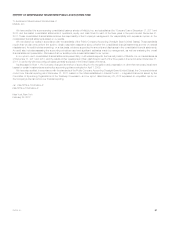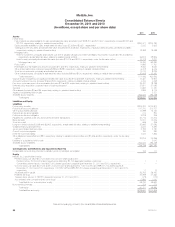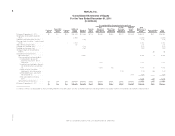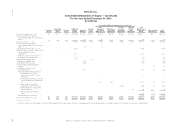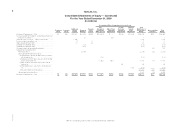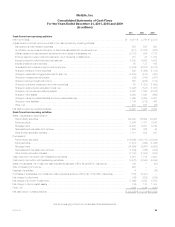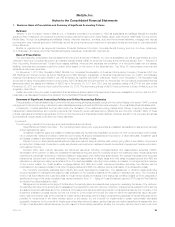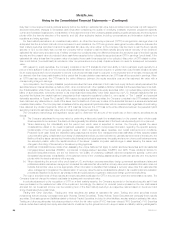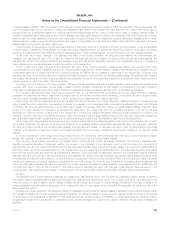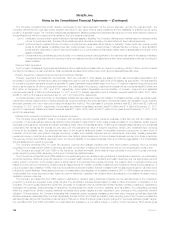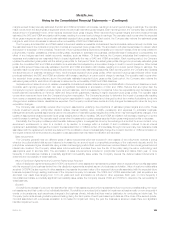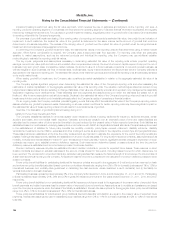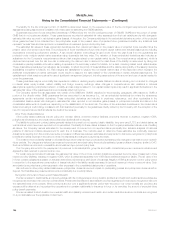MetLife 2011 Annual Report Download - page 100
Download and view the complete annual report
Please find page 100 of the 2011 MetLife annual report below. You can navigate through the pages in the report by either clicking on the pages listed below, or by using the keyword search tool below to find specific information within the annual report.MetLife, Inc.
Notes to the Consolidated Financial Statements — (Continued)
likely than not be required to sell a particular security before the decline in estimated fair value below amortized cost recovers; (vii) with respect to
structured securities, changes in forecasted cash flows after considering the quality of underlying collateral; expected prepayment speeds;
current and forecasted loss severity; consideration of the payment terms of the underlying assets backing a particular security; and the payment
priority within the tranche structure of the security; and (viii) other subjective factors, including concentrations and information obtained from
regulators and rating agencies.
For fixed maturity securities in an unrealized loss position, an other-than-temporary impairment (“OTTI”) is recognized in earnings when it is
anticipated that the amortized cost will not be recovered. In such situations, the OTTI recognized in earnings is the entire difference between the
fixed maturity security’s amortized cost and its estimated fair value only when either: (i) the Company has the intent to sell the fixed maturity
security; or (ii) it is more likely than not that the Company will be required to sell the fixed maturity security before recovery of the decline in
estimated fair value below amortized cost. If neither of these two conditions exist, the difference between the amortized cost of the fixed maturity
security and the present value of projected future cash flows expected to be collected is recognized as an OTTI in earnings (“credit loss”). If the
estimated fair value is less than the present value of projected future cash flows expected to be collected, this portion of OTTI related to other-
than credit factors (“noncredit loss”) is recorded in other comprehensive income (loss). Adjustments are not made for subsequent recoveries in
value.
With respect to equity securities, the Company considers in its OTTI analysis its intent and ability to hold a particular equity security for a
period of time sufficient to allow for the recovery of its estimated fair value to an amount equal to or greater than cost. If a sale decision is made
for an equity security and it is not expected to recover to an amount at least equal to cost prior to the expected time of the sale, the security will
be deemed other-than-temporarily impaired in the period that the sale decision was made and an OTTI loss will be recorded in earnings. When
an OTTI loss has occurred, the OTTI loss is the entire difference between the equity security’s cost and its estimated fair value with a
corresponding charge to earnings.
Upon acquisition, the Company classifies perpetual securities that have attributes of both debt and equity as fixed maturity securities if the
securities have an interest rate step-up feature which, when combined with other qualitative factors, indicates that the securities have more debt-
like characteristics; while those with more equity-like characteristics are classified as equity securities within non-redeemable preferred stock.
Many of such securities, commonly referred to as “perpetual hybrid securities,” have been issued by non-U.S. financial institutions that are
accorded the highest two capital treatment categories by their respective regulatory bodies (i.e. core capital, or “Tier 1 capital” and perpetual
deferrable securities, or “Upper Tier 2 capital”). With respect to perpetual hybrid securities, the Company considers in its OTTI analysis whether
there has been any deterioration in credit of the issuer and the likelihood of recovery in value of the securities that are in a severe and extended
unrealized loss position. The Company also considers whether any perpetual hybrid securities, with an unrealized loss, regardless of credit rating,
have deferred any dividend payments. When an OTTI loss has occurred, the OTTI loss is the entire difference between the perpetual hybrid
security’s cost and its estimated fair value with a corresponding charge to earnings.
The Company’s methodology and significant inputs used to determine the amount of the credit loss on fixed maturity securities are as
follows:
(i) The Company calculates the recovery value by performing a discounted cash flow analysis based on the present value of future cash
flows expected to be received. The discount rate is generally the effective interest rate of the fixed maturity security prior to impairment.
(ii) When determining the collectability and the period over which value is expected to recover, the Company applies the same
considerations utilized in its overall impairment evaluation process which incorporates information regarding the specific security,
fundamentals of the industry and geographic area in which the security issuer operates, and overall macroeconomic conditions.
Projected future cash flows are estimated using assumptions derived from management’s best estimates of likely scenario-based
outcomes after giving consideration to a variety of variables that include, but are not limited to: general payment terms of the security; the
likelihood that the issuer can service the scheduled interest and principal payments; the quality and amount of any credit enhancements;
the security’s position within the capital structure of the issuer; possible corporate restructurings or asset sales by the issuer; and
changes to the rating of the security or the issuer by rating agencies.
(iii) Additional considerations are made when assessing the unique features that apply to certain structured securities such as residential
mortgage-backed securities (“RMBS”), commercial mortgage-backed securities (“CMBS”) and ABS. These additional factors for
structured securities include, but are not limited to: the quality of underlying collateral; expected prepayment speeds; current and
forecasted loss severity; consideration of the payment terms of the underlying assets backing a particular security; and the payment
priority within the tranche structure of the security.
(iv) When determining the amount of the credit loss for U.S. and foreign corporate securities, foreign government securities and state and
political subdivision securities, management considers the estimated fair value as the recovery value when available information does not
indicate that another value is more appropriate. When information is identified that indicates a recovery value other than estimated fair
value, management considers in the determination of recovery value the same considerations utilized in its overall impairment evaluation
process as described in (ii) above, as well as private and public sector programs to restructure foreign government securities.
The cost or amortized cost of fixed maturity and equity securities is adjusted for OTTI in the period in which the determination is made. The
Company does not change the revised cost basis for subsequent recoveries in value.
In periods subsequent to the recognition of OTTI on a fixed maturity security, the Company accounts for the impaired security as if it had
been purchased on the measurement date of the impairment. Accordingly, the discount (or reduced premium) based on the new cost basis is
accreted into net investment income over the remaining term of the fixed maturity security in a prospective manner based on the amount and
timing of estimated future cash flows.
Trading and Other Securities. Trading and other securities are stated at estimated fair value. Trading and other securities include
investments that are actively purchased and sold (“Actively Traded Securities”). These Actively Traded Securities are principally fixed maturity
securities. Short sale agreement liabilities related to Actively Traded Securities, included in other liabilities, are also stated at estimated fair value.
Trading and other securities also includes securities for which the fair value option (“FVO”) has been elected (“FVO Securities”). FVO Securities
include certain fixed maturity and equity securities held-for-investment by the general account to support asset and liability matching strategies for
96 MetLife, Inc.



